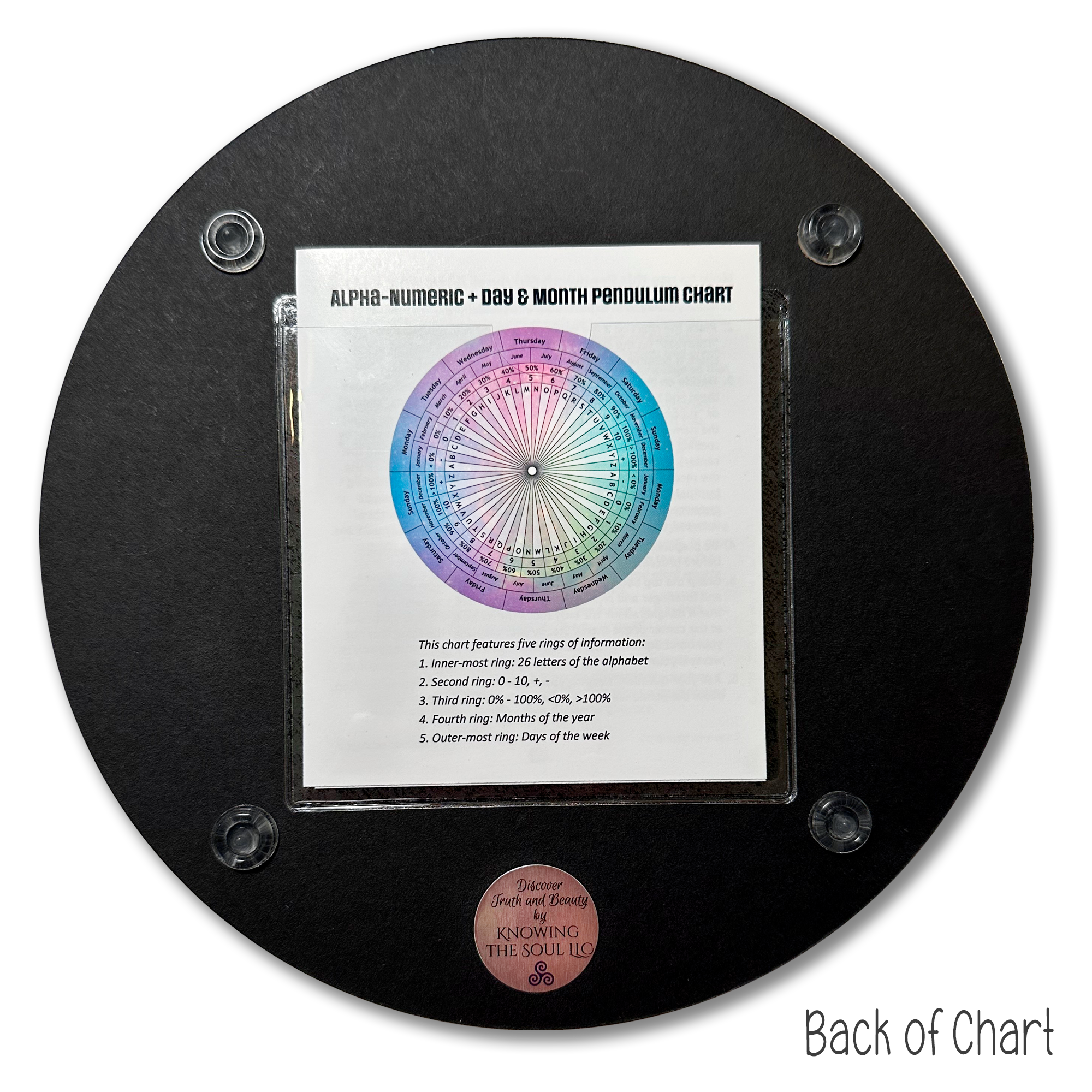Alpha-Numeric Pendulum Chart - 8 inch Aluminum
This product is available for purchase at our Etsy shop.
This chart is available at our Etsy Shop.
Ask your pendulum to spell it out! This multi-purpose pendulum chart features letters, numbers, percentages, days of the week, and 12 months. The background is a pretty, star-sprinkled nebula of violet, pink, blue, and green.
Designed and created in the Knowing the Soul studio, our exclusive, 8" glossy aluminum, full-color pendulum chart is divided into multiple wedges, including the 26 letters of the alphabet, numbers (-0 through 10+), percentages (<0% - >100%), seven days of the week, and twelve months of the year. Included with chart is an instruction booklet that slips into a handy pocket on the back of the chart.
Details
The chart's rich, vibrantly colored artwork is permanently embedded into its specially coated glossy aluminum surface that won't fade or chip over time. Chart sits on four silicone foot-pads. 22 gauge aluminum chart surface is manufactured in the USA. Chart measures 8" wide/high and 1/3" high. It weighs 3 1/2 ounces. Each chart is handmade with love by Eva Browning.
2024 chart design copyright Knowing the Soul LLC. All Rights Reserved. Designed, printed, and packaged in the USA by Knowing the Soul LLC. A note from the creator: This chart is the product of my own hard work, research and/or creativity, to which I hold the copyright thereto and reserve all rights.
How to Use
- Clear your mind of expectations and predictions.
- Place the chart on a flat surface in front of you, positioned so that "Thursday" (in the outer ring) is at the top and the bottom of the chart. If possible, sit up straight and put both feet flat on the floor.
- Decide on the question you’re going to ask. Use details if you have them and be as specific as possible. Avoid using the words “should” or “supposed to” in your phrasing. If you’re asking questions about the name of a person, place or thing, your pendulum will answer by spelling it out, letter by letter, using the first ring (starting from the center). If your question can be answered with numbers, you’ll use the second ring from the center. If your question can be answered by a percentage, you’ll use the third ring. If your question can be answered by days of the week, use the fourth ring. For months of the year, use the fifth, or outer ring.
- Be prepared with a pencil and paper. Write down your question before proceeding.
- Grasp the top bead or fob of your pendulum between your thumb and forefinger and arch your wrist slightly. Hold your pendulum so that it dangles about 1/2 inch above the hinge-point (the white dot at the center of the chart). Steady your elbow on the table, but not your hand that holds the pendulum. Try to hold very still, but don’t worry if your hand shakes a little bit. This won’t affect the outcome.
- Ask your question. Keeping your elbow and grip in the same position, allow the pendulum as much time as it needs to pick a direction.
- Focusing on the ring of data that fits your question (i.e., letters in the inner ring), read the answer by watching the pendulum’s motion. A steady swing that repeatedly passes over the hinge point in a straight line indicates the data shown below the pendulum’s path (in the ring you are focused on). Write it down and continue for the next part (letter, number, or percentage) of the answer. Repeat until the answer is complete. During the answering process, if you aren’t sure when your pendulum is done, you can move off the chart and, with your pendulum programmed for yes/no answers, or using a Yes/No pendulum chart, ask a clarifying yes/no question, such as, “Are there more letters in this word?” Or you can repeat out loud what you have written down so far, and ask, “Is this the complete answer?” Depending on how you phrased this clarification question, a simple yes or no will tell you whether to continue gathering data from the chart.
- Clear the pendulum at the end of each question by touching its weight-stone to the palm of your free hand or another surface.
Click here for tips and more information about use pendulum charts.





